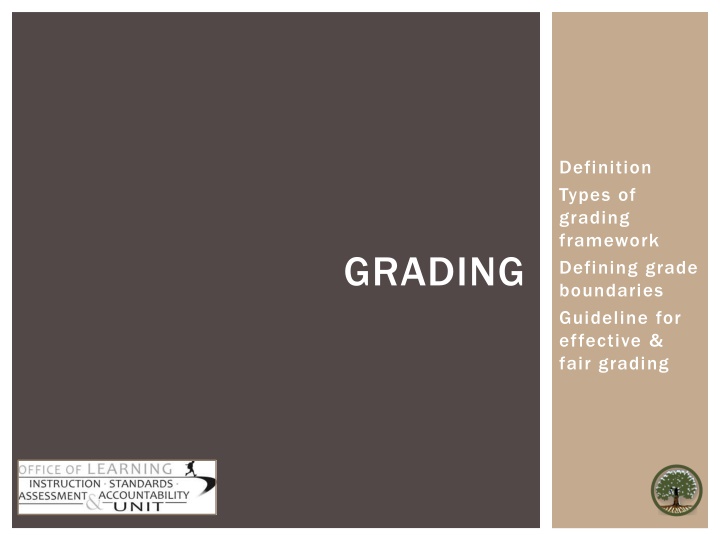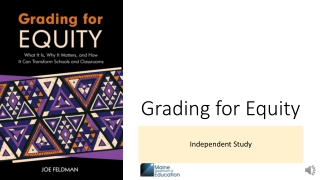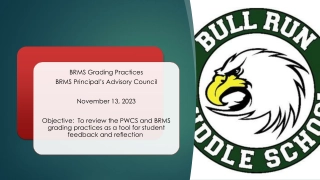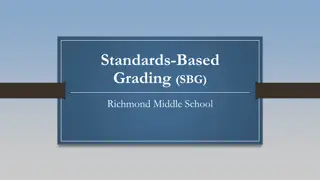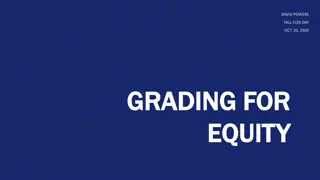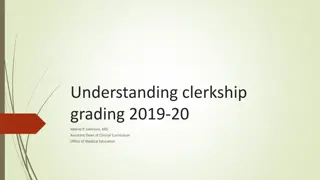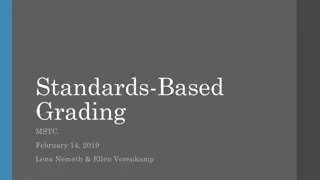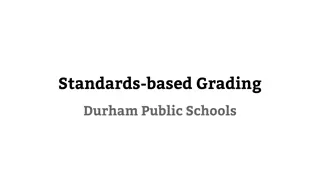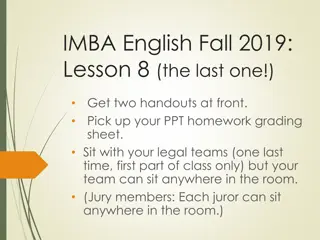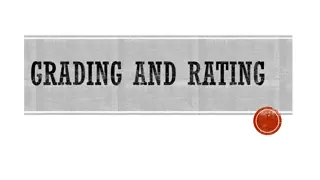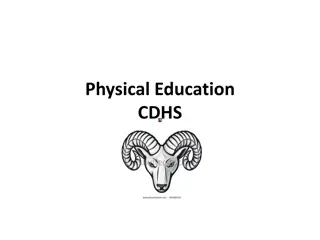Types of Grading Framework & Guidelines for Effective Grading
A grade signifies the attainment of learning outcomes with grading relying on value judgment. The distinction between scoring and grading is elucidated, emphasizing the influence of teacher discretion on assigning grades. The importance of clear grading policies that motivate and meet students' needs is highlighted. Various types of grading frameworks, including Absolute Criterion, Relative Norm, and Self-referencing, are discussed along with their advantages and disadvantages. The context differentiates between task-referencing and group-referencing methods, shedding light on the subjectivity and objectivity of grading procedures.
Download Presentation

Please find below an Image/Link to download the presentation.
The content on the website is provided AS IS for your information and personal use only. It may not be sold, licensed, or shared on other websites without obtaining consent from the author.If you encounter any issues during the download, it is possible that the publisher has removed the file from their server.
You are allowed to download the files provided on this website for personal or commercial use, subject to the condition that they are used lawfully. All files are the property of their respective owners.
The content on the website is provided AS IS for your information and personal use only. It may not be sold, licensed, or shared on other websites without obtaining consent from the author.
E N D
Presentation Transcript
Definition Types of grading framework Defining grade boundaries Guideline for effective & fair grading GRADING
DEFINITION A grade represents the extent to which the intended learning outcomes have been achieved Grading and scoring are not the same Scoring (using a rubric) involves assigning an objective description to a student s performance Grading involves a value judgment; the same score can be assigned different grades based on a number of factors Two different teachers might assign different grades to the same scores in different classrooms One teacher might assign a score one grade at the beginning of a term when the students are just learning, and a lower grade at the end of the term when students are expected to know much more.
DEEFINITION, CONTINUED School should have clearly defined grading policies The grading system should aim to motivate, encourage, and meet the students learning needs Grading is based on teacher s academic judgment
TYPES OF GRADING (1) 1. Absolute Criterion-/task-referencing based on a defined set of standards when evaluating a student s performance Advantages Advantages Disadvantages Disadvantages No reference to the performance of others Performance standards are difficult to specify and justify, as they may vary unintentionally due to variations in test difficulty, student ability, and instructional effectiveness May be subject to rater s subjectivity All students can obtain high grades
TYPES OF GRADING (2) 2. Relative Norm-/group-referencing: based on how a student s performance compared to others in a group/class Advantages Advantages Disadvantages Disadvantages Easy to interpret as it describes a rank in a group Provides inconsistent interpretation as the meaning of a grade varies with the ability of the student group Can be assigned without using a clear reference to specific student performance Can discriminate among levels of student performance
TYPES OF GRADING (3) 2. Self-referencing Growth-/change-based: based on the teacher s/rater s perspectives of improvement, growth, or change that a particular student has performed in comparison with his/her prior learning. Advantages Advantages Disadvantages Disadvantages Reduces competition among student as it may induce motivation in learning Increases teacher s autonomy in assessment May allow a student not to achieve the learning targets Relies on teacher s judgment
DEFINING GRADE BOUNDARIES* Relative to school s policy and the chosen grading framework (criterion or norm-referenced) Norm-referenced Percentage of students at each grade Criterion-referenced Fixed-percentage Total points Rubric method * As modified from Nitko & Brookhart (2007, Chapter 15). For further reference, please consult this book.
GRADING ON THE CURVE 1. Rank order students overall scores 2. Set the percentages of letter grade As, Bs, Cs and so on that a student can fall into Divide the range of a normal curve into specific intervals E.g. top 20% of students get A, next 30% get B, next 30% get C, next 15% get D, lowest 5% get F 3. Record the grade for these set grade boundaries Can be arbitrary No reference to the intended learning targets Should provide sound argument to justify the validity of the particular percentages used
GRADING USING FIXED-PERCENTAGE METHOD 1. Give a percentage correct score for each student for each task 2. Multiply each task s percentage by its corresponding weight and add these products together 3. Divide the sum of products by the sum of weights to get a composite percentage score 4. Translate this final score to letter grade Relationship between percentage correct and letter grade is arbitrary follow school policy This method may encourage us to focus more on the task difficulty than on the intended learning outcomes.
GRADING USING TOTAL POINTS METHOD 1. Assign a maximum point value for each task 2. Sum these maximum points 3. Use the maximum possible total values to set the letter-grade boundaries 4. Translate this final score to a letter grade Easy to adjust or give extra credits to an assessment task to increase scores of students with low performance
GRADING USING RUBRIC METHOD* (1) Assign an ordered number to each level of rubrics. Higher number represents a higher complexity Summing across components Calculate the sum or the average of the numbers, or use fixed percentage method Care is needed to avoid grade distortion (e.g. 3 on a 4-point rubric is 75%; converting this to a grade of C may not make sense) * As modified from Nitko & Brookhart (2007, Chapter 15). For further reference, please consult this book.
GRADING USING RUBRIC METHOD* (2) Using minimum attainment A student meets the minimum standards in order to pass A student s high score on one component of the assessment does not compensate for his/her low score on other components * As modified from Nitko & Brookhart (2007, Chapter 15). For further reference, please consult this book.
GUIDELINE FOR EFFECTIVE & FAIR GRADING* (1) 1. Inform scoring/grading procedures to students at the beginning of instruction To better inform expectations of students To motivate student s learning and promote student s critical thinking 2. Base grades on student achievement of the intended learning outcomes, not other factors Other factors such as student s tardiness, misbehavior, effort, etc. should be reported separately, if needed 3. Use a wide variety of valid assessment data Using several different assessment tasks can provide good validity evidence to justify the meaning of the grade given * As modified from Waugh & Gronlund (2013, pp. 200-201)
GUIDELINE FOR EFFECTIVE & FAIR GRADING* (2) 4. When combining scores for grading, use a proper weighting technique Consider the spread/variability of the scores from a particular test/assessment task when defining weights 5. Select an appropriate frame of reference for grading Use of Learning Progression Map as the standards of reference Give examples of standards For conventional classroom assessment, Use absolute grading for pass/fail (P/F) decision when the minimum standards of achievement have been set Use relative grading to assign a grade above P/F level to describe how a student has achieved the intended outcomes with higher degree of cognitive skills
GUIDELINE FOR EFFECTIVE & FAIR GRADING* 6. Review borderline cases by reexamining all achievement evidence Re-evaluate the borderline student s performance in all assessment tasks given Favor a higher grade Cautions of giving a Failing grade (F): Given to a student who consistently performs below the minimum standards of achievement Notion of measurement error of an observed score * As modified from Waugh & Gronlund (2013, pp. 200-201)
BIBLIOGRAPHY Ebel, R. L., & Frisbie, D. A. (1991). Essentials of educational measurement. Englewood Cliffs, NJ: Prentice-Hall. Nitko, A. J., & Brookhart, S. (2007). Educational assessment of students. Upper Saddle River, NJ: Pearson Education, Inc. McMillan, J. H. (2007). Classroom assessment. Principles and practice for effective standard-based instruction (4th ed.). Boston: Pearson - Allyn & Bacon. Popham, W. J. (2014). Classroom assessment: What teachers needs to know. San Francisco, CA: Pearson Russell, M. K., & Airasian, P. W. (2012). Classroom assessment: Concepts and applications. New York, NY: McGraw-Hill. Waugh, C. K., & Gronlund. (2013). Assessment of student achievement (10th Ed.). Upper Saddle River, NJ: Pearson Education.
CREATIVE COMMONS LICENSE Grading PPT by the Oregon Department of Education and Berkeley Evaluation and Assessment Research Center is licensed under a CC BY 4.0. You are free to: You are free to: Share Share copy and redistribute the material in any medium or format Adapt Adapt remix, transform, and build upon the material Under the following terms: Under the following terms: Attribution Attribution You must give appropriate credit, provide a link to the license, and indicate if changes were made. You may do so in any reasonable manner, but not in any way that suggests the licensor endorses you or your use. NonCommercial NonCommercial You may not use the material for commercial purposes. ShareAlike ShareAlike If you remix, transform, or build upon the material, you must distribute your contributions under the same license as the original. Oregon Department of Education welcomes editing of these resources and would greatly appreciate being able to learn from the changes made. To share an edited version of this resource, please contact Cristen McLean, cristen.mclean@state.or.us.
